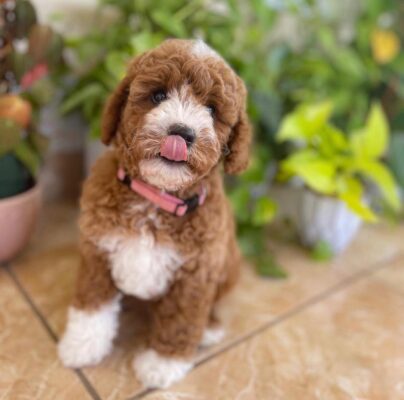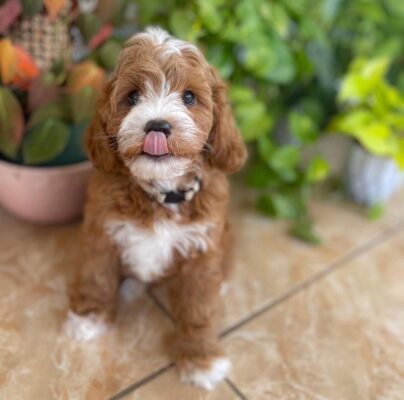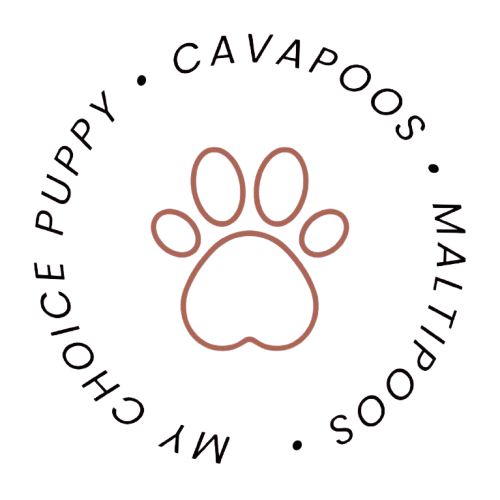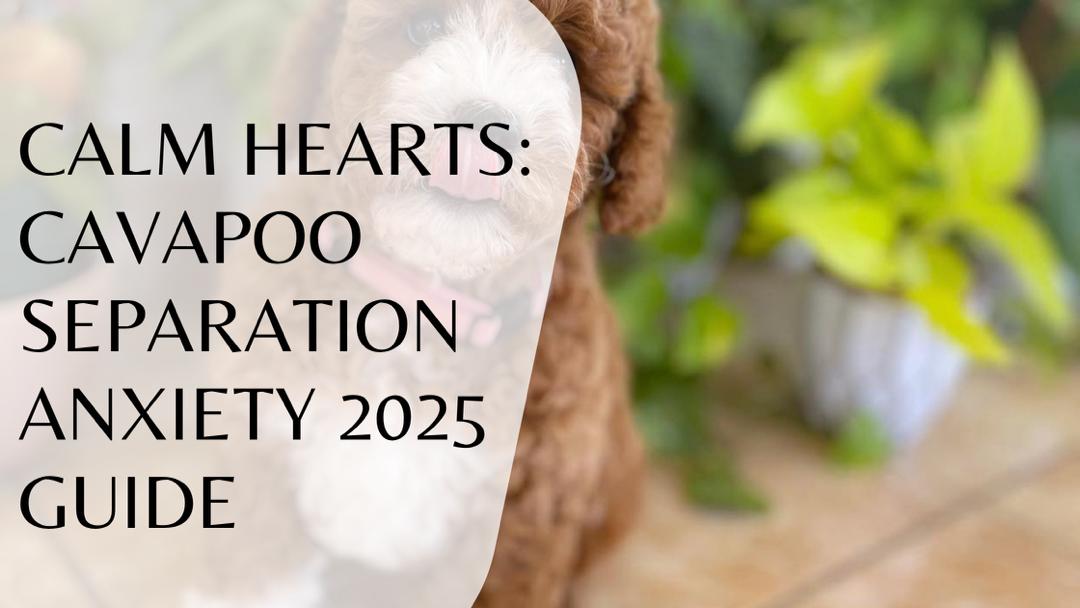CAVAPOO BLOG
Calm Hearts: Cavapoo Separation Anxiety 2025 Guide
Calm Hearts: Cavapoo Separation Anxiety 2025 Guide
Cavapoos are known for their loving, people-centered nature. They form deep bonds with their owners, which makes them one of the most affectionate and loyal companion dogs. However, this same sensitivity and devotion can also make them prone to a common behavioral challenge — separation anxiety. When left alone, some Cavapoos experience stress, fear, or panic, leading to behaviors like whining, destructive chewing, or pacing.
Understanding why Cavapoo separation anxiety happens and how to manage it is key to keeping your dog happy, secure, and emotionally balanced. This 2025 Cavapoo separation anxiety guide explores the root causes, symptoms, and proven solutions to help your dog stay calm when you’re away.
What Is Cavapoo Separation Anxiety
Cavapoo separation anxiety is a behavioral condition where your dog experiences emotional distress when separated from their owner. It’s not disobedience or a sign of poor training—it’s a natural reaction driven by fear of isolation. Since Cavapoos thrive on companionship and close human contact, being left alone can make them feel confused and vulnerable.
This condition can occur at any age, though it’s most common in young Cavapoo puppies adjusting to new routines. In mild cases, you might notice whining or pacing. In severe cases, your Cavapoo might bark excessively, scratch doors, or even soil inside the house despite being potty trained. (CountryLiving/PDSA)

Why Cavapoos Are Prone to Separation Anxiety
Cavapoos inherit traits from two highly affectionate breeds: the Cavalier King Charles Spaniel and the Poodle. Both breeds were developed to be companion dogs, meaning they crave human attention and do not cope well with solitude. A Cavapoo’s intelligence also plays a role—these dogs quickly associate cues like picking up keys or putting on shoes with being left alone, which can trigger pre-separation anxiety before you even leave.
Routine changes, limited exercise, or lack of mental stimulation can make this anxiety worse. If your Cavapoo is used to constant attention and suddenly experiences longer periods of solitude, they may struggle to adapt.
Recognizing the Signs and Symptoms
Separation anxiety manifests differently in every Cavapoo, but there are common behavioral patterns that reveal emotional distress. Some Cavapoos begin pacing or whining when they sense their owner is leaving. Others bark, howl, or cry for hours until their person returns. You might notice chewed furniture, scratched doors, or shredded pillows—these behaviors are often an attempt to cope with panic, not defiance.
Other signs include excessive drooling, refusal to eat when alone, or restlessness during your absence. If you return home to a dog who clings to you and refuses to let you out of sight, separation anxiety is likely the cause.
The Emotional and Physical Impact
Persistent separation anxiety can affect your Cavapoo’s physical health. Elevated stress levels release cortisol, which can weaken the immune system and lead to issues such as digestive upset, loss of appetite, or excessive shedding. Emotionally, your Cavapoo may become hyper-attached, unable to relax even when you’re home. Over time, chronic anxiety can also lead to depression and reduced confidence.
For owners, dealing with the emotional toll of a stressed dog can be equally draining. That’s why addressing Cavapoo separation anxiety early is essential—for the well-being of both you and your companion.
Preventing Separation Anxiety in Cavapoo Puppies
Prevention begins early, ideally when your Cavapoo is still a puppy. Start by helping your puppy understand that being alone is safe and temporary. Create a predictable daily routine that includes regular feeding, play, and quiet time. Practice short separations by leaving your puppy alone for a few minutes and gradually increasing the duration. (NCBI Vet Met)
Encourage independence even while you’re home. Allow your Cavapoo to rest in another room occasionally rather than always being by your side. Reward calm, confident behavior with treats or gentle praise. Avoid excessive babying—constant attention can make your puppy overly dependent, increasing anxiety later.

Proven Ways to Manage Cavapoo Separation Anxiety
Managing Cavapoo separation anxiety takes time and consistency. The most effective approach is gradual desensitization. Begin by leaving your dog alone for short periods, such as five minutes, and slowly build up to longer durations. This teaches your Cavapoo that your absence is temporary and not something to fear.
Counterconditioning is another powerful method. Before you leave, give your Cavapoo a special toy or treat that they only get during your absence. This creates a positive association with being alone. Keep departures and arrivals calm and uneventful—dramatic goodbyes or excited greetings can reinforce anxiety.
A safe, comfortable environment also plays a major role. Set up a quiet space with your Cavapoo’s bed, toys, and a familiar blanket. Some owners use white noise machines or calming music to mask outside sounds that might startle their pup.
Mental and physical stimulation throughout the day reduces stress and energy buildup. Daily walks, training sessions, and interactive toys help your Cavapoo stay content when it’s time to rest alone.
Tools and Aids That Can Help
There are many helpful products designed to ease separation anxiety. Calming pheromone diffusers mimic the scent of a nursing mother dog and create a sense of comfort. Interactive feeding toys or slow-release treat dispensers keep your Cavapoo engaged when you’re not around.
Technology can also help. Dog cameras with audio let you monitor your pet and talk to them remotely. Weighted blankets or anxiety vests apply gentle, constant pressure that mimics a soothing hug. Before introducing supplements or calming aids, consult your veterinarian for safety and dosage.
Building Independence and Confidence
Helping your Cavapoo gain independence is a gradual process. Avoid rushing or overwhelming them. Begin by stepping out of sight for a few minutes while staying inside the house (GoodPup). Praise calm behavior and gradually extend the distance and duration. Eventually, you can leave the house entirely without triggering panic.
Avoid predictable departure cues like grabbing your keys at the same time every day. Mix up your routine so these signals lose their power to trigger anxiety. Reward calmness and quiet behavior after each separation session. With consistent practice, your Cavapoo will learn that being alone isn’t scary—it’s just another part of their daily rhythm.
When Professional Help Is Needed
If your Cavapoo shows severe symptoms—such as extreme panic, self-injury, or uncontrollable barking—it’s best to seek professional help. Certified dog behaviorists can create personalized training programs, and veterinarians can recommend anti-anxiety medication or supplements when necessary. Never punish anxious behavior, as it increases fear and damages trust.
Mistakes to Avoid
Many owners unintentionally worsen separation anxiety by making common mistakes. Overreacting when leaving or returning home reinforces the idea that absence is significant. Punishing destructive behavior only confuses your Cavapoo, making anxiety worse. Ignoring small signs like pacing or whining can allow the problem to escalate. Consistency and patience are the foundation of improvement.
Frequently Asked Questions
How common is Cavapoo separation anxiety?
It’s quite common. Because Cavapoos are bred for companionship, nearly half experience some degree of anxiety when left alone.
How can I tell if it’s anxiety or boredom?
If destructive behavior happens only when you’re away and your Cavapoo otherwise behaves normally, it’s likely anxiety.
Should I use a crate?
Yes, if your Cavapoo sees it as a safe den-like space. Introduce the crate gradually and never use it for punishment.
Can supplements help?
Natural remedies such as chamomile, L-theanine, or CBD oil can help, but consult your vet before trying any supplement.
Will getting another dog help?
Sometimes a second pet provides comfort, but it’s not guaranteed. Focus on confidence-building first.
How long does recovery take?
Each Cavapoo is different. With consistent training, improvement usually begins within weeks, but full recovery can take several months.
Final Thoughts
Cavapoo separation anxiety can be challenging, but with patience, structure, and understanding, it’s absolutely manageable. The key is consistency—creating a calm environment, practicing gradual separation, and maintaining positive reinforcement. Your Cavapoo’s anxiety stems from love and loyalty, and your goal is to show them that being alone is safe.
By following the guidance in this Cavapoo separation anxiety 2025 guide, you’ll build your dog’s confidence, reduce their fear, and strengthen your bond. Over time, your Cavapoo will learn that no matter how long you’re gone, you always come back—and that trust is the foundation of a calm, happy companion.

